
The Beach Boys are an American rock band formed in Hawthorne, California, in 1961. The group's original lineup consisted of brothers Brian, Dennis, and Carl Wilson, their cousin Mike Love, and friend Al Jardine. Distinguished by their vocal harmonies, adolescent-oriented lyrics, and musical ingenuity, they are one of the most influential acts of the rock era. They drew on the music of older pop vocal groups, 1950s rock and roll, and black R&B to create their unique sound. Under Brian's direction, they often incorporated classical or jazz elements and unconventional recording techniques in innovative ways.
Art rock is a subgenre of rock music that generally reflects a challenging or avant-garde approach to rock, or which makes use of modernist, experimental, or unconventional elements. Art rock aspires to elevate rock from entertainment to an artistic statement, opting for a more experimental and conceptual outlook on music. Influences may be drawn from genres such as experimental music, avant-garde music, classical music, and jazz.

Pet Sounds is the eleventh studio album by the American rock band the Beach Boys, released on May 16, 1966 by Capitol Records. It was initially met with a lukewarm critical and commercial response in the United States, peaking at number 10 on the Billboard Top LPs chart. In the United Kingdom, the album was lauded by critics and reached number 2 on the Record Retailer chart, remaining in the top ten for six months. Promoted there as "the most progressive pop album ever", Pet Sounds was recognized for its ambitious production, sophisticated music, and emotional lyrics. It is now considered to be among the greatest and most influential albums in music history.

Smiley Smile is the 12th studio album by American rock band the Beach Boys, released on September 18, 1967. Conceived as a simpler and more relaxed version of their unfinished Smile album, Smiley Smile is distinguished for its homespun arrangements, "stoned" aesthetic, and lo-fi production. Critics and fans generally received the album and its lead single, "Heroes and Villains", with confusion and disappointment. The album reached number 9 on UK record charts, but sold poorly in the US, peaking at number 41—the band's lowest chart placement to that point.

Carl and the Passions – "So Tough" is the 18th studio album by American rock band the Beach Boys, released May 15, 1972 on Brother/Reprise. The album is a significant musical departure for the band and is the first to feature the Flames' Blondie Chaplin and Ricky Fataar as additions to their official line-up. It sold poorly and was met with lukewarm reviews, but later gained stature as a cult favorite among fans.

"Good Vibrations" is a song by the American rock band the Beach Boys that was composed by Brian Wilson with lyrics by Mike Love. It was released as a single on October 10, 1966 and was an immediate critical and commercial hit, topping record charts in several countries including the United States and the United Kingdom. Characterized by its complex soundscapes, episodic structure and subversions of pop music formula, it was the most expensive single ever recorded. "Good Vibrations" later became widely acclaimed as one of the finest and most important works of the rock era.
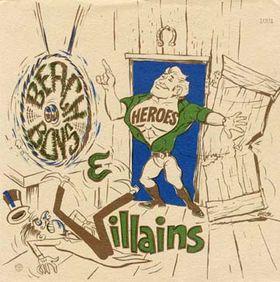
"Heroes and Villains" is a song by the American rock band the Beach Boys from their 1967 album Smiley Smile and their unfinished Smile project. Written by Brian Wilson and Van Dyke Parks, Wilson envisioned the song as an Old West-themed musical comedy that would surpass the recording and artistic achievements of "Good Vibrations". The single was Brother Records' first release. While it failed to meet critical and commercial expectations, it was a hit record, peaking at number 12 in the U.S. and number 8 in the UK.

"Along Comes Mary" is a song composed by Tandyn Almer, originally recorded by American sunshine pop band the Association. It was the group's first hit, released in March 1966 as the lead single prior to their debut album, And Then... Along Comes the Association, which appeared in July.
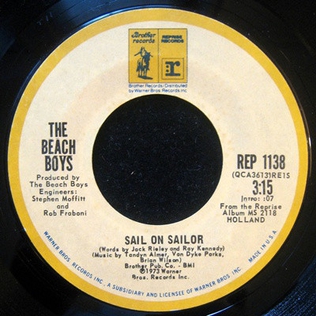
"Sail On, Sailor" is a song by American rock band the Beach Boys from their 1973 album Holland. It was written primarily by Van Dyke Parks and Brian Wilson with Ray Kennedy, Tandyn Almer, and Jack Rieley. The lead singer on the song is Blondie Chaplin, making this one of the band's few well-known songs not sung by Mike Love, Brian Wilson, or Carl Wilson. The song was released as a single in 1973, backed with "Only with You", and peaked at No. 79 on the Billboard singles chart. A 1975 reissue charted higher, at No. 49.

"Surf's Up" is a song recorded by the American rock band the Beach Boys that was written by Brian Wilson and Van Dyke Parks. It was originally intended for Smile, an unfinished Beach Boys album that was scrapped in 1967. The song was later completed by Brian and Carl Wilson as the closing track of the band's 1971 album Surf's Up.
"Wonderful" is a song by the American rock band the Beach Boys from their 1967 album Smiley Smile and their unfinished Smile project. Written by Brian Wilson and Van Dyke Parks, it was their only collaboration that resulted in a love song, telling the story of a young girl's sexual awakening and its disruption of her devotion to God and her parents.

"You Need a Mess of Help to Stand Alone" is a song by American rock band the Beach Boys from their 1972 album Carl and the Passions – "So Tough". It was written by Brian Wilson and Jack Rieley, and was issued as the album's lead single with the B-side "Cuddle Up". The single failed to chart.
"Little Pad" is a song by the American rock band the Beach Boys from their 1967 album Smiley Smile. It was written by Brian Wilson and its working title had been "Hawaiian Song". On the track, the group sings in unison about wanting a "little pad in Hawaii" while accompanied by a Hawaiian guitar, an organ, and clip-clop percussion.
Tandyn Douglas Almer was an American songwriter, musician, and record producer who wrote the 1966 song "Along Comes Mary" for the Association. He also wrote, co-wrote, and produced numerous other songs performed by artists such as the Beach Boys, the Purple Gang, the Garden Club, and Dennis Olivieri. In the early 1970s, he was a close friend and collaborator of Brian Wilson, co-writing the Beach Boys' singles "Marcella" (1972) and "Sail On, Sailor" (1973).
"Fire" is an instrumental by American musician Brian Wilson that he originally composed for the Beach Boys' never-finished album Smile. Named after Catherine O'Leary and the Great Chicago Fire, the track was originally conceptualized as part of "The Elements", a four-part movement based on the four classical elements: Air, Fire, Earth, and Water. Wilson's friends, family, and colleagues later referred to its recording as heralding his period of psychosis and the unraveling of the Smile project.

Smile is an unfinished album by the American rock band the Beach Boys that was intended to follow their 1966 album Pet Sounds. It was to be an LP of twelve tracks assembled from modular fragments, the same editing process used for their "Good Vibrations" single. Instead, after a year of recording, the album was shelved and the group released a downscaled version, Smiley Smile, in September 1967. Over the next four decades, few of the original Smile tracks were officially released, and the project came to be regarded as the most legendary unreleased album in popular music history.
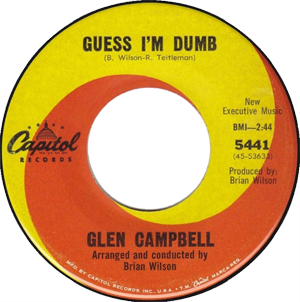
"Guess I'm Dumb" is a song recorded by American singer Glen Campbell that was released as his seventh single on Capitol Records on June 7, 1965. Written by Brian Wilson and Russ Titelman, it is a love song that describes a man who regrets ending a relationship after he realizes he still harbors deep feelings for his former lover. The single failed to chart.
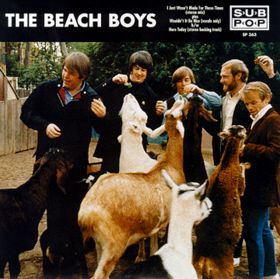
"I Just Wasn't Made for These Times" is a song by American rock band the Beach Boys from their 1966 album Pet Sounds. Written by Brian Wilson and Tony Asher, the lyrics describe the disillusionment of someone who struggles to fit into society. Musically, it is distinguished for its melodic bass guitar, layered vocals, and Electro-Theremin solo, marking the first time the instrument was used in popular music and the first time theremin-like sounds were used on a rock record.

Lei'd in Hawaii is an unfinished live album by American rock band the Beach Boys that was produced shortly after the completion of their 1967 studio album Smiley Smile. It was initially planned to include the band's first live concert performances since their tour of Europe in May 1967.
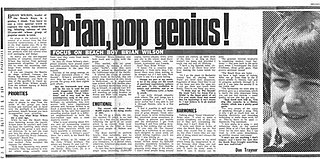
"Brian Wilson is a genius" is a line that became part of a media campaign spearheaded in 1966 by the Beatles' former press officer Derek Taylor, who was then employed as the Beach Boys' publicist. Although there are earlier documented expressions of the statement, Taylor frequently called Brian Wilson a "genius" as part of an effort to rebrand the Beach Boys and legitimize Wilson as a serious artist on par with the Beatles and Bob Dylan.















